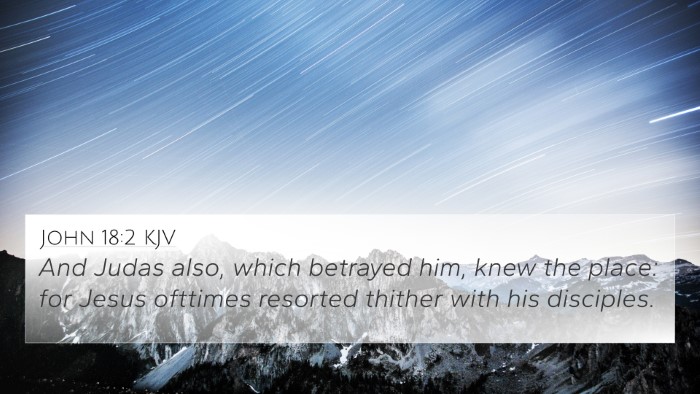Understanding John 12:4: Insights from Public Domain Commentaries
John 12:4 states: "But Judas Iscariot, one of his disciples, he that should betray him, said." This verse sets a critical stage in the narrative leading to the betrayal of Jesus by Judas Iscariot. Public domain commentaries such as those by Matthew Henry, Albert Barnes, and Adam Clarke provide significant insights into its meaning and implications.
Contextual Overview
This passage occurs shortly before the Passion Week, during which Judas Iscariot's motives become pivotal. The phrase "one of his disciples" highlights Judas's intimate connection to Jesus, underscoring the tragic nature of his eventual betrayal.
Commentary Insights
-
Matthew Henry:
Henry emphasizes the irony of Judas's role, as he was chosen to be a disciple yet succumbed to greed. He discusses Judas's motivations and warns readers about the dangers of letting worldly desires overshadow spiritual commitments.
-
Albert Barnes:
Barnes notes that the mention of Judas serves as a foreshadowing of the betrayal that would result in Jesus's crucifixion. He highlights how Judas's actions serve as a lesson in hypocrisy, as he outwardly followed Christ while plotting against him.
-
Adam Clarke:
Clarke focuses on the characteristics of Judas, presenting him as a figure of warning. He suggests that Judas's betrayal was rooted in a series of poor choices, illustrating how a heart can drift from good to evil.
Exploring Thematic Connections
The verse in John 12:4 connects thematically to several other Bible passages:
- Matthew 26:14-16: Describes Judas's agreement to betray Jesus for thirty pieces of silver.
- Acts 1:16-20: Discusses the consequences of Judas’s betrayal, emphasizing the fulfillment of prophecy regarding his actions.
- Luke 22:3-6: Indicates that Satan entered Judas, showcasing the spiritual battle influencing his decisions.
- John 13:2: Refers to the devil putting it into Judas's heart to betray Jesus, emphasizing the spiritual betrayal at play.
- Psalm 41:9: A prophetic verse regarding betrayal by a close friend, which Jesus quotes regarding Judas.
- Mark 14:10-11: Further recounts Judas’s betrayal and the conspiracy with the chief priests.
- John 6:70-71: Jesus acknowledges that Judas is a devil, highlighting the warning against false followers.
Linking Bible Scriptures: The Narrative of Betrayal
The narrative of John 12:4 interconnects deeply with the themes of loyalty, betrayal, and the human propensity toward sin, prompting profound reflection on the nature of discipleship. By analyzing the connections between the verses, readers can discern a fabric of theological insights about following Christ authentically.
Cross-Referencing Biblical Texts
For those interested in exploring the concept of cross-referencing, John 12:4 serves as a vital touchpoint. Here are some tools and methods for a deeper study:
- Tools for Bible Cross-Referencing: Utilize a Bible concordance for thematic connections. A cross-reference Bible study enables the identification of links not immediately apparent.
- Bible Cross-Reference Guide: Various guides can direct readers to related scriptures that enhance understanding of betrayal and redemption.
- Cross-Referencing Bible Study Methods: Incorporate thematic studies by focusing on betrayal in the Bible through connected verses.
Practical Application
Understanding John 12:4 within its broader context aids believers in recognizing the challenges of faith. Reflecting on betrayal invites a deeper examination of one’s commitment to Christ and the authenticity of one’s discipleship.
Conclusion
John 12:4 serves not merely as a historical account but as a rich source for spiritual reflection and practical application. By engaging with various commentaries and connecting this verse to related scriptures, one can explore the layers of meaning woven through Holy Scripture. This examination can aid in sermon preparation, personal study, and understanding the complexity of biblical themes.
In conclusion, as you delve into this scripture and its connections with other verses, consider how these insights guide you in your personal faith journey and community discussions.










